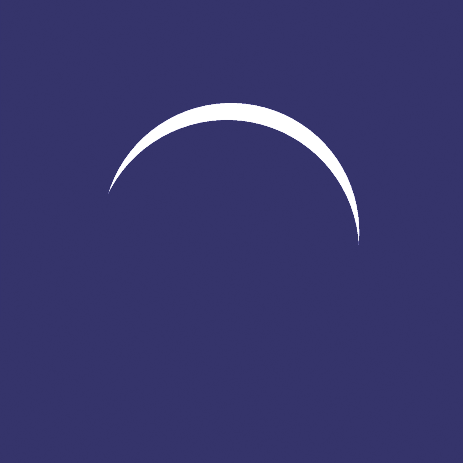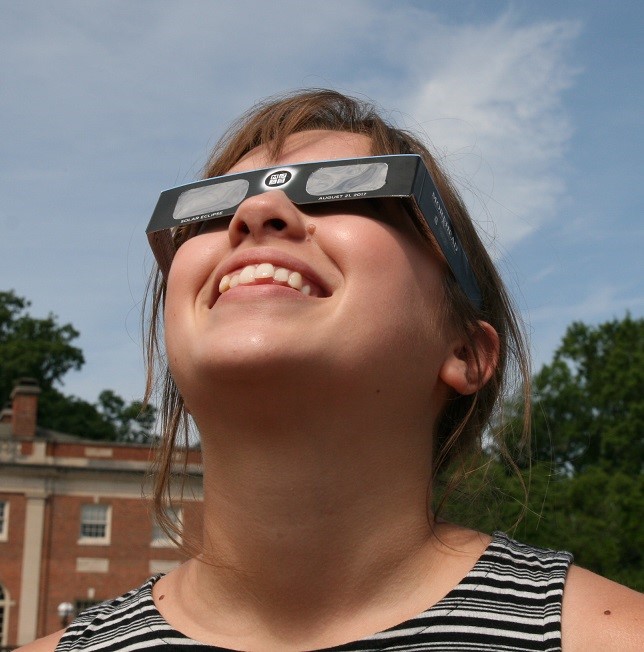10 things for North Carolinians to know about the eclipse
August 1, 2017
By Amy Sayle
1. When is the solar eclipse?
Monday, August 21, 2017. For North Carolina, this is an afternoon event, happening from roughly 1 to 4 p.m. (times vary by location). Over about three hours, the Moon will appear to pass in front of the Sun and cast a shadow on Earth. Anyone standing in the Moon’s shadow can experience the eclipse.
For most of North Carolina, this will be only a partial solar eclipse, with the Moon never appearing to fully cover the Sun. The far southwestern corner of our state also gets a total solar eclipse because it lies in the “path of totality,” a roughly 70-wide-path cutting across the continent from Oregon to South Carolina.
NASA’s 2017 eclipse site has a zoomable interactive map. (Subtract 4 from UT to get Eastern time.) You can also find maps of the path through North Carolina here, and South Carolina here.
2. How much of the Sun will be covered from North Carolina?

A lot. The exact fraction of the Sun’s area covered by the Moon at the time of maximum eclipse depends on where you are, e.g., 88% from Elizabeth City, 93% Triangle area, 94% Triad area, 96% Boone and Wilmington, 97% Lumberton, 98% Charlotte, and 99% Asheville.
The lucky folks in the far southwestern corner get totality – 100% of the Sun will be covered for up to about 2 minutes 40 seconds for those on the center line of the path of totality, starting around 2:35 p.m. (times vary by location).
Everyone getting the total eclipse also gets the partial eclipse before and after. In fact, all of North America and northern South America get a partial eclipse that day.
3. What will this look like from Chapel Hill?
From the Morehead Sundial in downtown Chapel Hill, the partial eclipse starts at 1:15 p.m. and ends at 4:05 p.m. At 2:43 p.m. the eclipse is at its maximum, with 93% of the Sun covered.
Use NASA’s interactive map to figure out the details for your location. Be sure to subtract 4 from Universal Time (UT) to translate to Eastern Daylight Time. Otherwise, you’ll miss the whole thing.
4. What’s the big deal about totality?
If you want to experience the total solar eclipse – said to be the most awe-inspiring sight nature has to offer – then you must go to the path of totality. Not close to the path (sorry, Asheville) but in it. That’s where you want to be to witness day turning to night, see planets and stars becoming visible, view the Sun’s corona, and make memories sure to last a lifetime.
A 93% eclipsed Sun, such as in Chapel Hill, might sound impressive, but it’s not 93% of the full experience. Don’t expect the sky to go dark. Seven percent of the Sun shining is still a lot of light.
The difference between a witnessing a partial solar eclipse and a total solar eclipse has been described as the difference between flying in an airplane and jumping out of it. It is, quite literally, the difference between day and night.
Need to convince someone in your life that the path of totality is the place you need to be? Check out some of the quotes in this article – https://moreheadplanetarium.org/2017eclipse or read about the experience of totality here.
5. Where should I go to see this?
See a map of (selected) eclipse events in North Carolina and South Carolina at https://moreheadplanetarium.org/eclipse
If you have the resources, definitely plan to go to a location in the path of totality. Because that path includes much of South Carolina, depending on where in North Carolina you live it may be easier for you to drive to the path of totality in South Carolina.
Traffic on August 21st will probably be . . . interesting. Consider if there’s somewhere you can stay the night before, and maybe the night after. At this late date, you may find it difficult or impossible to reserve a room or campsite in the path of totality, but perhaps you know someone living in the path who would host you.
Then there’s the weather. Find detailed information on August cloudiness derived from years’ worth of satellite observations at http://eclipsophile.com/overview/. For cloud data specific to the Carolinas, see http://eclipsophile.com/georgia-and-the-carolinas/
Really, you should go to the path of totality if you can. But if you can’t, we’d love to see you at Morehead Planetarium and Science Center. Our eclipse celebration runs from 12 to 4:30 p.m. on Monday, August 21, 2017.
The Morehead event will offer short planetarium shows. Those seats are limited; register online in advance (a pair of eclipse glasses is included with your ticket). We’ll also have free activities, including a live stream of the eclipse and hands-on educational activities. Expect food trucks, a water station, and more. Eclipse glasses will be available for sale until they run out. Of course, our ability to view the partial eclipse from Chapel Hill will depend on the weather that day.
6. How do I view the eclipse safely?
Don’t mess around with your eye safety. Take a few minutes to read NASA’s eclipse safety page.
An easy, cheap, and surprisingly satisfying method for viewing the Sun (whether it’s partially eclipsed or just another ordinary day) is eclipse glasses. But make sure you get eclipse glasses made by a manufacturer that followed the appropriate standards. See the list at https://eclipse2017.nasa.gov/safety.
You can also learn more about safely viewing the eclipse at https://eclipse.aas.org/eye-safety/safe-viewing.
7. When’s the last time we had a total solar eclipse?
Witnessing a total solar eclipse from any specific location is a rare event. On average, total solar eclipses occur only once every 375 years for a given spot.
The last time we had a total solar eclipse…
…anywhere in the United States was July 11, 1991 (part of Hawaii).

…in the 48 states was February 26, 1979 (parts of WA, OR, ID, MT, ND).
…in North Carolina was March 7, 1970 (part of eastern NC)
…crossing our entire continent was June 8, 1918.
Clicking the dates above will take you to a map of the path of totality for that eclipse.
8. When’s the next time the U.S. gets a total solar eclipse?
April 8, 2024. Also a Monday. As was the 1979 eclipse. Apparently, the universe likes to give us excuses for 3-day weekends.
The 2024 path of totality runs on a path from Texas to Ohio to Maine. Alas, North Carolina gets only a partial solar eclipse that day.
9. When does part of North Carolina get another total solar eclipse?
The next total solar eclipse for North Carolina is May 11, 2078. At the Morehead Planetarium Sundial, we’ll experience 3 minutes and 1 second of totality. Mark your calendar! (That one’s a Wednesday.)
10. Where can I learn more?
To see a simulation of the total solar eclipse in our planetarium theater, attend any of the Carolina Skies shows this summer. It’s on the schedule six days a week and is recommended for adults, and children ages 8 and up.
At the August 2nd Carolina Science Café, we’ll be presenting about the eclipse. That’s in Chapel Hill at Top of the Hill’s Back Bar.
Also check out NASA’s 2017 eclipse site and the American Astronomical Society’s site. The Morehead eclipse page includes a map of eclipse events in the Carolinas, along with links to safety information, resources, and educational activities.
